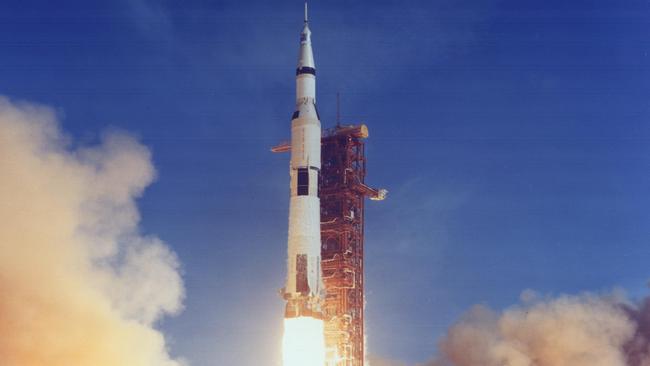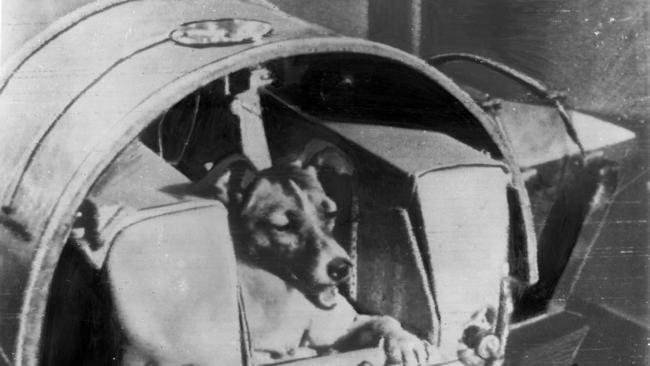Man on the moon: a giant leap for technology
The race to the moon created new technology and new ideas about innovation.

Computers in the home. Spin-offs with computers for industry and medicine, and new techniques for mapping. This is bread-and-butter stuff in 2019. In the prism of 1962, they are remarkable ideas about future technology.
That’s what US president John F. Kennedy alluded to in his famous speech on technology and space at Rice University in Houston, Texas, in 1962.
Watching that remarkable, impassioned 18-minute speech is a great place to start to understand the genesis and motivation of the US effort to step out onto the moon with Apollo 11.
We also need to credit Kennedy’s great speechwriter, Ted Sorensen, who penned the initial drafts of the speech, and to then vice-president Lyndon Johnson, who chaired the US National Aeronautics and Space Council at the time the moon venture was proposed in 1961. Johnson and the council saw the idea as a winning strategy when consulted by Kennedy.
Ironically, Johnson as president in the late 1960s presided over big budget cuts to the space effort when the US focused its efforts and money on the Vietnam War.
Let’s cut to the chase. The motivation to go to the moon was always to beat the Soviet Union and restore wounded US pride, not primarily to explore new worlds, although the world was captivated by each successive mission. The Soviets had dealt the US a shellacking with three big firsts in space. In the 60s, everyone referred to it as “the space race”. It was a technology Olympics between two superpowers.
The Soviet Union had thrashed the Americans launching the first satellite, Sputnik 1, in 1957 followed by the first Earth creature in space, Laika the dog in Sputnik 2. It showed that creatures could withstand the G-forces associated with travelling into space, but the idea was condemned.

Laika, a stray mutt from the streets of Moscow, was on a one-way trip as there was no way to return her to Earth. It was originally thought she would starve to death or suffocate, but after the fall of the Soviet Union, in fact in this century, it emerged that Laika had died from overheating and stress after only about four orbits. Her pulse rate had spiked threefold at launch before plummeting in orbit.
Soviet cosmonaut Yuri Gagarin became the first human to orbit Earth, less than three months into Kennedy’s presidency.
A week after Gagarin orbited Earth, Kennedy faced the crisis of the aborted invasion of Cuba at the Bay of Pigs and later that year the construction of the Berlin Wall.
Soviet-US relations couldn’t have been worse when Kennedy gave his speech about technology and space in 1962. In those 18 minutes, he sold the moon venture as much more than a space race.
There was the pitch about the money: “That (space) budget now stands at $US5400 million a year — a staggering sum, though somewhat less than we pay for cigarettes and cigars every year,” he told the university audience.

He acknowledged that technology is neither good or evil: “For space science, like nuclear science and all technology, has no conscience of its own. Whether it will become a force for good or ill depends on man.”
He went on to say: “We have vowed that we shall not see space filled with weapons of mass destruction, but with instruments of knowledge and understanding.”
The moon push was expected to have major spin-offs for technology on Earth. “The growth of our science and education will be enriched by new knowledge of our universe and environment, by new techniques of learning and mapping and observation, by new tools and computers for industry, medicine, the home as well as the school,” Kennedy said.
There was the much quoted line that the US was going to the moon and doing other things “not because they are easy, but because they are hard”.

The most moving part to me was when Kennedy detailed the enormity of the Apollo mission.
“But if I were to say, my fellow citizens, that we shall send to the moon, 240,000 miles (386,000km) away from the control station in Houston, a giant rocket more than 300 feet tall, the length of this football field, made of new metal alloys, some of which have not yet been invented, capable of standing heat and stresses several times more than have ever been experienced, fitted together with a precision better than the finest watch, carrying all the equipment needed for propulsion, guidance, control, communications, food and survival, on an untried mission, to an unknown celestial body, and then return it safely to Earth, re-entering the atmosphere at speeds of over 25,000 miles per hour, causing heat about half that of the temperature of the sun … and do all this, and do it right, and do it first before this decade is out — then we must be bold.”
No doubt some in the audience thought Kennedy (and Johnson) crazy rather than just bold. This was seven years before Neil Armstrong and Buzz Aldrin ventured on to the moon’s surface, and talking about using alloys yet to be invented would have sounded like science fiction.

That Kennedy’s pronouncements in 1962 became true in 1969 is what makes Apollo 11 so special. It’s not just that they got to the moon, it’s the amazing way the engineering, scientific and technical communities around the globe rallied and worked to make what seemed impossible reality.
Australia played a major role capturing the telemetry feeds containing data about the performance of the command module and lunar module, astronauts’ health data, and the TV signals travelling across space.
Observatories at Parkes, Honeysuckle Creek, Tidbinbilla and Carnarvon were among those that were pivotal.
An Australian measured moon dust on that mission. Apollo 11 carried a device created by Brian O’Brien, a fellow of the Australian Academy of Technology and Engineering. The 270g Plexiglas box with solar cells attached measured moon dust. He had been at Rice University in the mid-1960s. He said there were four on the moon from Apollos 11, 12, 14 and 15.
The US won the space race and the Soviets gave up and never put men or women on the moon. In 1967, The Soviet Union, US and Britain signed an Outer Space Treaty that among many points says you can’t claim sovereignty of the moon and other celestial bodies. That took the sting out of some unsavoury repercussions.
John Sarkissian, an operations scientist at Parkes Radio Observatory, found reference to a Soviet facility near Simferopol in Crimea that was set up to monitor the signals from the US lunar module. A document published in 2007 and translated from Russian says the centre tracked Apollo 8, 10, 11 and 12 from December 1968 to November 1969.
“From all these ships telephone conversations of astronauts with the Earth and the telemetering information on the condition of on-board systems were accepted with high quality,” the Russian document says. “The accepted television signal had poor quality.”
That’s interesting because the Soviet Union (and others) spread the rumour that the moon landing was fake when the Soviets no doubt knew from this facility that it wasn’t.
The 50th anniversary on July 20 and 21 is worth celebrating for another reason. Sadly, only about half the astronauts who flew Apollo missions are still alive, and they are in their 80s and 90s. Only four astronauts who walked on the moon were alive in May this year. The ranks of ground staff, including scientists and engineers, are quickly dwindling too.
So the 50th anniversary is a special chance to celebrate with them. And we should ensure their contributions are documented and recorded orally and on video, even holographically, for generations to come.




To join the conversation, please log in. Don't have an account? Register
Join the conversation, you are commenting as Logout